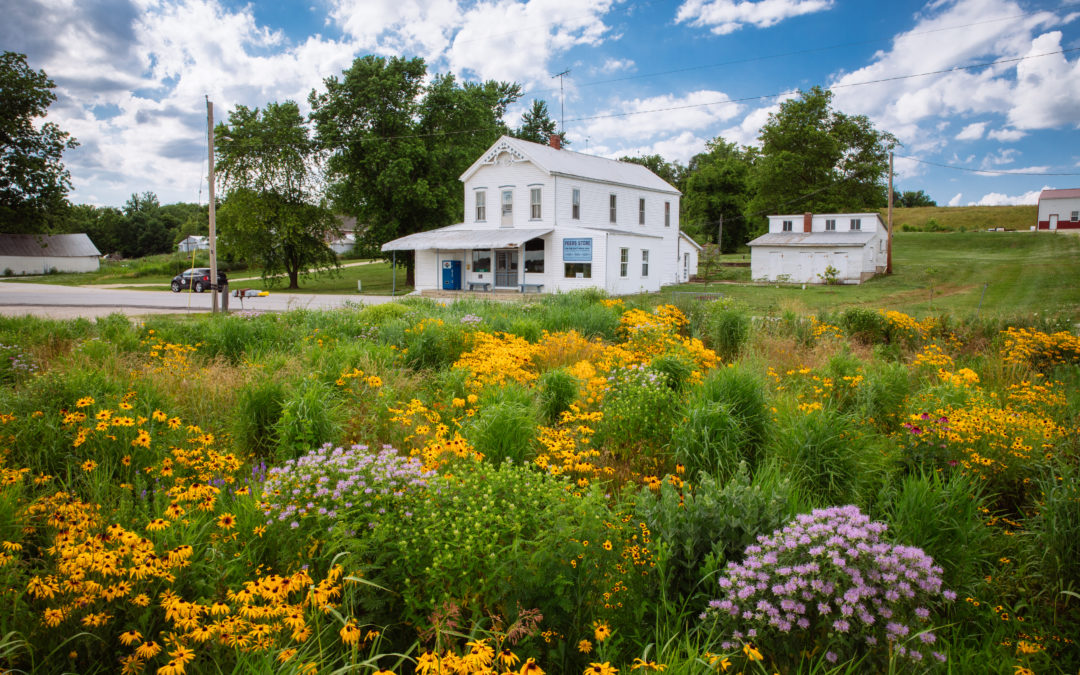Four-Acre Planting Is a Buffet for Wildlife, a Respite for Trail Users and So Much More
By Karen Cernich Dickhut
One of the joys of riding the Katy Trail is the diversity of wildlife that you see and hear along the way, particularly birds, and one of the best places to experience this is the Peers Prairie, a 4-acre planting of native flowers and grasses tucked in a patch of land between Peers Store and the Katy Trail. The railroad right of way is generally about 50 feet wide, but in many places — like Peers, Treloar and Marthasville — where there were Katy Railroad facilities, there are larger parcels, like this one, that were part of the railroad. Magnificent Missouri recognized the potential for this open area, and State Parks gave Magnificent Missouri permission to plant and maintain the prairie.
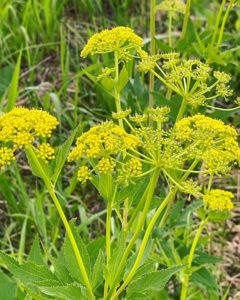
Golden Alexander blooming at the Peers Prairie
If you’ve never stopped here before during a trail ride, add it to your list of must-sees. If you’re a birdwatcher, you might want to make a special trip to Peers just to check it out (Peers Prairie Day, set for Saturday, June 18, would be an excellent option). And don’t forget your binoculars.
The prairie is like a 24-hour buffet for birds, particularly the American Goldfinch, whose diet is “granivorous,” which means it eats the seeds of plants like those growing here. The bee balm, for example, is a year-round food source. If you visit Peers Prairie right now, you’ll see Golden Alexanders, Foxglove Beardtongue, Plains Coreopsis, Lanceleaf Corepsis, Slender Mountain Mint and Prairie Cinquefoil blooming. Later in the summer or fall, there will be coneflowers, Black Eyed Susans, Asters, Blue Vervain, Rosinweed and more. There’s always something flowering, it seems.
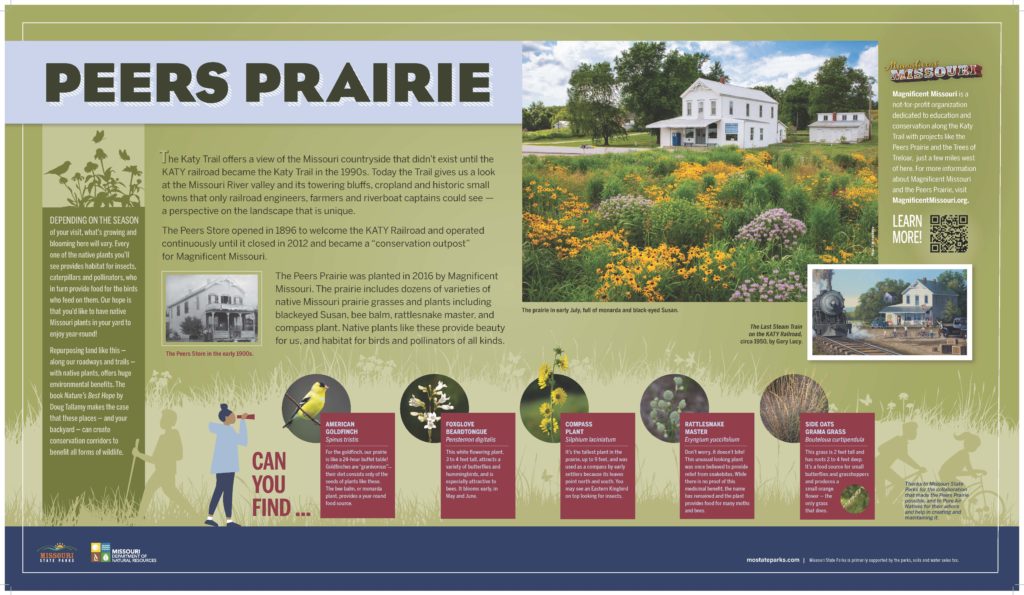
This information board at the edge of the prairie provides details to help you identify plants and learn more about their benefits.
Prairie plants provide habitat for a diversity of insects, caterpillars and pollinators. The Rattlesnake Master provides food for moths and bees, the Compass Plant (the tallest in the prairie, growing up to 9 feet!) serves as a perch for the Eastern Kingbird while hunting for insects, and the Sideoats Grama Grass, which produces a small orange flower, is a food source for small butterflies and grasshoppers.
And that’s not even to mention what the prairie is doing for you as you pedal, walk or run by on the trail — or better yet, walk along the short path cut into the prairie to get a truly immersive experience. The beauty of the plants provides serenity, likely reducing your blood pressure and relieving stress, and the plants themselves also function as air filters, actually removing pollution so you can breathe easier.
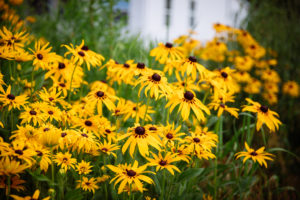
Black-Eyed Susans blooming in the Peers Prairie
Provide Erosion Control, Water Filtration & Rebuild the Soil
There are many other ecological benefits that come with a prairie. Along with wildlife habitat and carbon sequestration, they provide stormwater infiltration, improved water quality and superior erosion control, according to Becky Mahon, who has been involved with creating and caring for the Peers Prairie since it was planted in 2016 by DJM Ecological Services under the leadership of Magnificent Missouri. It’s a result of their extensive root systems, which can reach as far down as 5 to 15 feet. In this way, prairie plants actually anchor the soil, Mahon noted. They also increase soil organic matter and rebuild the soil.
But here a few benefits that homeowners or anyone who has to care for plants will appreciate: prairie plants require less long-term maintenance than traditional landscaping and they provide resistance to invasive species.
Advice to Homeowners
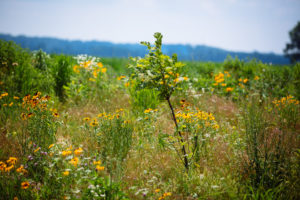
If you like the sound of that, you might want to consider adding prairie plants to your home landscape or even converting a small patch of your yard into a prairie. It is possible, said Mahon. Of course, site prep is critical, she stressed. That begins with weed control before you plant. It’s important to eliminate anything that might compete with prairie seedlings. Mowing and herbicide applications are critical to rid the seed bank of as much as possible, Mahon said. There are lots of weeds with seeds viable in the soil for 20 years, so starting as clean from the beginning as you can is helpful, she explained. Depending on the site conditions, it will take three to five years to establish a prairie, even a small one.
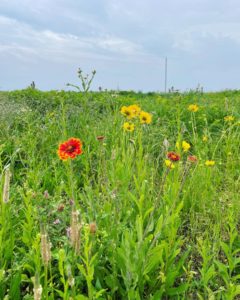
Her advice to homeowners ready to take on the challenge is to keep it simple and be patient. “Use species that you can identify and know your weeds,” she said, noting there are a lot of good apps to help with that.
Mahon has been restoring Midwest native ecosystems, including prairies like the one at Peers, for 10 years as a member of DJM Ecological Services. At Peers, she provided the initial site assessment, recommended the site prep activities, and her crew installed the seed. Since then, they’ve been doing monthly stewardship on the prairie during each growing season.
Her hope is that the beauty of the Peers Prairie will lead to a greater understanding and appreciation of prairies and their benefits.
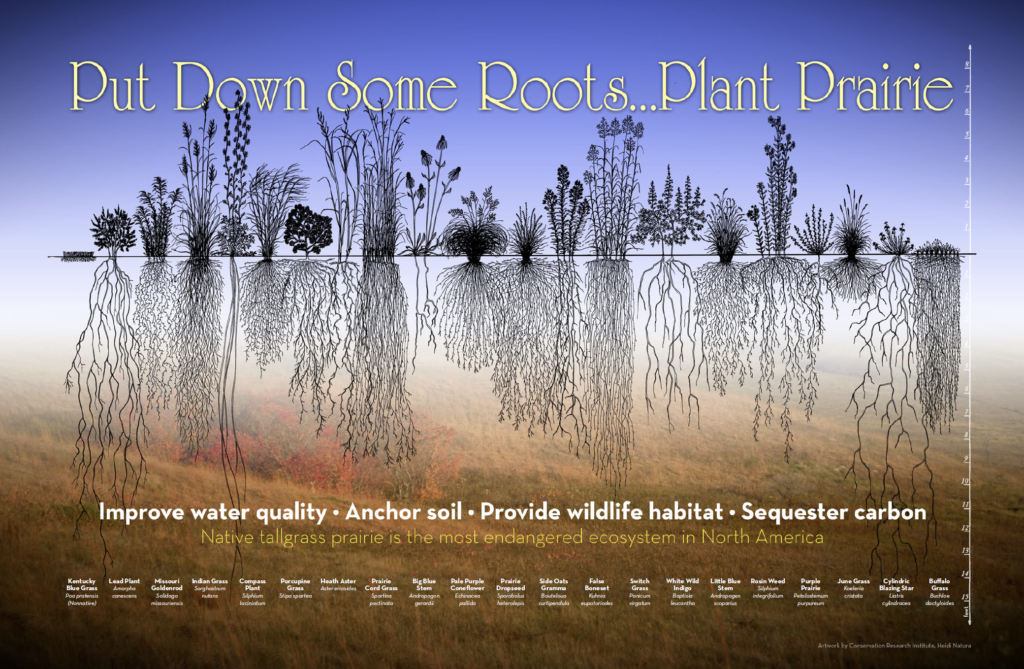
Thanks to their extensive root system (5 to 15 feet deep), prairie plants provide stormwater infiltration, improved water quality and superior erosion control.
